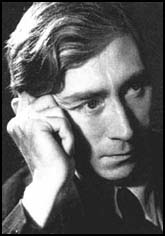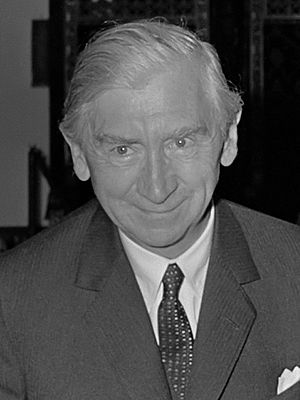Herbert Read facts for kids
Quick facts for kids
Herbert Read
DSO MC
|
|
|---|---|
 |
|
| Born | Herbert Edward Read 4 December 1893 Muscoates, North Riding of Yorkshire, England |
| Died | 12 June 1968 (aged 74) Stonegrave, North Riding of Yorkshire, England |
| Occupation | Art historian, modern art historian, and literary and art critic |
| Period | 1915–1968 |
Sir Herbert Edward Read (born December 4, 1893 – died June 12, 1968) was an English art historian, poet, writer, and thinker. He is famous for his many books about art, especially those that talked about how important art is in education.
Read helped start the Institute of Contemporary Arts. He was also a well-known English anarchist, which means he believed in a society without government rulers. He was one of the first English writers to notice a way of thinking called existentialism, which focuses on human freedom and responsibility. He also helped edit the English version of The Collected Works of C. G. Jung.
Contents
Early Life and War Service
Herbert Read was the oldest of four children. He was born at Muscoates Grange in Yorkshire, England. His father was a farmer. When his father died, the family had to leave their farm because they were tenants, not owners.
Young Herbert was sent to a school for orphans in Halifax. His mother found a job in Leeds, and Herbert later joined her there. He started studying at the University of Leeds, but his studies were stopped by the start of the First World War.
During the war, Read served as a soldier with the Green Howards in France. He became a captain and was recognized for his bravery. He received two important awards: the Military Cross (MC) and the Distinguished Service Order (DSO).
While serving in the war, Read helped create a magazine called Arts & Letters. This was one of the first magazines to publish works by famous writers like T. S. Eliot.
Early Writings and Ideas
Read's first book of poems, Songs of Chaos, came out in 1915. His next collection, Naked Warriors (1919), was inspired by his experiences fighting in the trenches during the First World War. His poems often used free verse, a style without a regular rhyme or rhythm. His Collected Poems was published in 1946.
As a literary critic, Read mostly wrote about the English Romantic poets. He also paid close attention to a poetry style called Imagism. He wrote a novel called The Green Child. For many years, he was a regular art critic for The Listener magazine.
Read was also very interested in how to write well. He cared a lot about writing style and how things were put together. He shared his ideas in his book English Prose Style (1928). This book is still considered one of the best guides on how to write clear and elegant English.
Art Criticism and Modern Art
Herbert Read was a big supporter of modern British artists. He championed artists like Paul Nash, Ben Nicholson, Henry Moore, and Barbara Hepworth. He was part of Paul Nash's art group called Unit One.
Read worked as a professor of fine arts at the University of Edinburgh from 1931 to 1933. He also edited The Burlington Magazine, which was a very influential art magazine. In 1936, he helped organize the London International Surrealist Exhibition. He also edited a book called Surrealism that year.
He served as a trustee for the Tate Gallery and as a curator at the Victoria & Albert Museum. In 1947, he helped start the Institute of Contemporary Arts with Roland Penrose. Read was one of the first English writers to notice existentialism, a philosophy that explores human existence and freedom. He was also influenced by the thinker Max Stirner.
From 1953 to 1954, Read was a special professor at Harvard University. He also gave important lectures on fine arts at the National Gallery of Art.
Poetry and Its Meaning
Read believed that "true poetry was never speech but always a song." He thought poetry should be like music. This idea came from his teachers and other poets like T. E. Hulme and Marianne Moore.
His book Form in Modern Poetry (1932) was his main guide to understanding poetry. Critics said his poetry had a "white ecstasy of intellect" and was "terse poetry of austere beauty," meaning it was clear, smart, and beautiful. This style was clear in his early collection, Eclogues (1914-18).
Anarchism and Philosophy
Politically, Read called himself an anarchist. This meant he believed in a society without a government or rulers, where people could organize themselves freely. His ideas were peaceful, similar to those of Edward Carpenter and William Morris.
In 1953, he accepted a knighthood for his contributions to literature. This honor meant he was called "Sir Herbert Read." However, many other anarchists were upset by this because they believed anarchists should not accept honors from the government.
It's hard to separate Read's writings on politics from his writings on art and culture. He saw them all as connected parts of how humans express themselves. He wrote over 1,000 books and articles.
His book To Hell With Culture talks about his dislike for the word "culture." He believed that art and culture should not be separate from everyday life. He saw artists as skilled workers, like artisans.
Read's philosophical ideas were similar to those of thinkers like Friedrich Schelling and Samuel Taylor Coleridge. He believed that what we see as reality is partly created by our own minds, not just something outside of us. This meant that art was not just a product of society, but a natural part of human thinking.
Read was also very interested in psychoanalysis, which is a way of understanding the human mind. He was one of the first in the English-speaking world to use psychoanalysis to understand art and literature. He first followed the ideas of Sigmund Freud, but later preferred the ideas of Carl Jung. He even became the editor of Jung's collected works in English.
By 1949, Read was interested in the ideas of French Existentialists, especially Jean-Paul Sartre. Even though Read never called himself an existentialist, he agreed with many of their ideas about human freedom and choice.
Views on Education
Read became very interested in education, especially art education. His anarchist beliefs influenced his ideas about learning.
During the Second World War, he was asked to collect children's drawings and paintings for an exhibition. He was deeply moved by the power and feelings in these young artists' works. This experience made him focus on the value of children's creativity.
He wrote important books like Education through Art (1943). In this book, Read argued that every child has creative abilities that should be encouraged. He believed that if these abilities are not stopped by traditional education, children can grow into well-rounded people. He thought that everyone is an artist in some way, and even small creative abilities should be supported.
Read believed that art education could help people understand each other better across the world. From 1946 until he died in 1968, he was the president of the Society for Education in Art. He used this position to speak to UNESCO, a United Nations organization for education, science, and culture. Because of his efforts, the International Society for Education through Art (INSEA) was created in 1954 as part of UNESCO.
Death and Legacy
After Herbert Read died in 1968, his ideas were not as popular for a while. However, his work continued to influence others. For example, his writings on anarchism inspired Murray Bookchin to explore the links between anarchism and protecting the environment.
In 1971, a collection of his writings on anarchism was republished. In the 1990s, people became interested in his work again. There was a big exhibition in 1993 at Leeds City Art Gallery. More of his books have been republished since then.
The library at the Cyprus College of Art is named after him. So is the art gallery at the University for the Creative Arts in Canterbury. For many years, the Institute of Contemporary Arts in London held an annual Herbert Read Lecture, where famous speakers like Salman Rushdie shared their ideas.
On November 11, 1985, Read was one of 16 poets from the First World War honored at Westminster Abbey's Poet's Corner. A stone was placed there with an inscription written by another war poet, Wilfred Owen. It says: "My subject is War, and the pity of War. The Poetry is in the pity."
You can hear a recording of Read reading his work, titled The Surrealist Object, on an audiobook CD called Surrealism Reviewed.
Herbert Read was the father of several well-known children, including the writer Piers Paul Read, the BBC documentary maker John Read, and the art historian Ben Read.
Selected works
Critical works
- What is a Poem (1926)
- Phases of English Poetry (1928)
- Form in Modern Poetry (1932)
- Art and Industry (1934)
- Education Through Art (1943) later revised
- The True Voice of Feeling (1953)
- The Paradox of Anarchism (1955)
- Philosophy of Anarchism (1957)
- A Concise History of Modern Painting, 'The World of Art Library' series (1959)
- Art and Alienation (1967)
- Essays in Literary Criticism (1969)
Poetry
- A World Within A War (1943)
- Collected Poems (1966)
Autobiography
- Innocent Eye (1933). A childhood autobiography
- The Contrary Experience (1963). Autobiography
Prose
- Wordsworth; The Clark Lectures 1929-30 (1930)
- In Retreat (1930)
- Ambush (1931)
- Arp (The World of Art Library) (1931)
- The Meaning of Art (1931, rev. 1968)
- Art and Alienation (1932)
- The Redemption of the Robot – My Encounter with Education through Art (1933)
- Art Now (1933)
- My Anarchism (1934)
- The Green Child (1935)
- Unit One (1935), editor
- To Hell With Culture (1941)
- Eric Gill (1938)
- The Contrary Experience: autobiographies (1938)
- Introduction to Hubris: A Study of Pride by Pierre Stephen Robert Payne (1940)
- The Tenth Muse (1941)
- Icon and Idea (1943)
- Revolution & Reason (1945)
- The Art of Sculpture (1949)
- Education for Peace (1950)
- Existentialism, Marxism and Anarchism, Chains of Freedom (1951)
- English Prose Style (1952)
- Art and Society (1953)
- Anarchy & Order; Poetry & Anarchism (1959)
- Collected Essays in Literary Criticism (1960)
- The Grass Roots of Art (1963)
- Art Now (1963)
- Wordsworth (1966)
- Naked Warriors (1967)


